| Cobb Cold Air Intake
on EJ25 NA
By Dave
An engine has to breathe in to make power. Stock intakes
are a compromise between getting in a good amount of air and being
unobtrusive to the driver. The stock SOHC Legacy EJ25 uses a nice
example of this. Unlike the previous generations, Subaru designed
an intake that pulled cold air from the grille instead of the fender.
This is the same setup used on the overseas turbo models, but it's
no replacement for the actual turbos. It does look pretty cool though,
for about 18 inches. Three resonators and some flex-pipe later we
get to the filter box, placed right at the throttle body.
There are a lot of replacements for this stock system
that make power, but have drawbacks. The shorter an intake on a naturally-aspirated
car, the more low-end torque it will lose. Air flowing into the engine
works better if it's stacked and has a chance to flow. One of the
more popular intakes, the Ganzflow, replaces the plumbing before the
airbox and uses the stock filter. This is a pretty good solution,
and is relatively simple, with straight pipes. It doesn't replace
the whole system, so it doesn't resolve the clunky, square filter
box and funky airflow across the filter and into the manifold.
Cobb addressed this by replacing everything and using
an inline filter. By doing this, it smooths the intake into one, long
stretch with a nice bend down. Using a compact inline filter eliminates
the messy, bad-flowing airbox. Not only is it easier to get to, but
it looks cool and performs better. The long piping going to the fender
creates that stack effect, which helps maintain the healthy torque
of the stock system. The placement of the air intake in the fender
retains the cold air source.
Based on a good reputation for performance parts and
reviews by NASIOC members, i decided that the Cobb part was the one
to get. A week after getting the car i took a trip down to Cobb with
every intention to purchase one. Unfortunately, they didn't have any
in stock and weren't expecting any for two weeks. A display model
was looked into, but apparently included a hole for the IAT sensor,
which my year wasn't supposed to have. Oh well, two weeks would give
me a better feel for the car's performance and allow for better judgement
of any change.
Two weeks later i returned, after confirming that they
had the parts in. Justin and Noah set one aside for me, and also offered
some space in the garage to do an install, if i was so inclined. Since
Josh wasn't working on any project at the time, and i wasn't in the
way, i accepted the offer and went about tearing into the works. It
quickly became apparent that we'd all been wrong about the IAT. My
car had the sensor after all, so the two week wait was mostly in vain.
Oh well.

First off was the inlet, followed by the first elbow
section and flexpipe. The second elbow went quickly, followed by the
rear half of the airbox. Filter removed, i unscrewed the throttle
body clamp and removed the rest of the airbox. Finally i took out
the first resonator. At this point, i noticed that the two struts
that hold the stock airbox wouldn't be used at all. In the case of
the passenger-side unit, it looked to be in the direct path of new
intake, so it was quickly and easily removed. The driver side, however,
has two hard-to-get-to bolts lower on the transmission. I don't have
small hands, and it seemed that putting the car on a lift would make
the operation easier. Another day perhaps. At this point, i noticed
that the bracket on the strut tower was not going to be used at all.
The only thing connecting to it was a ground from the intake manifold.
I proceeded to remove the bracket and mounted the ground in one of
the lower bolt holes. Much cleaner. Finally, i reinstalled the bolt
that held down the big resonator box. It also secures the bracket
that mounts the ABS unit, so it's probably a good thing to have.

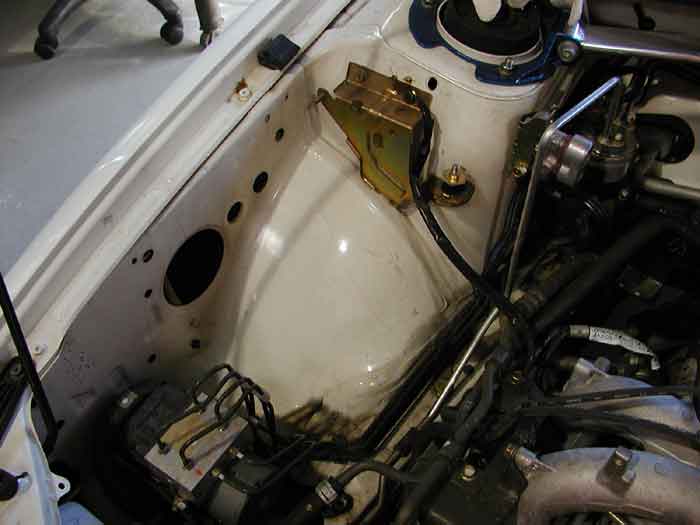
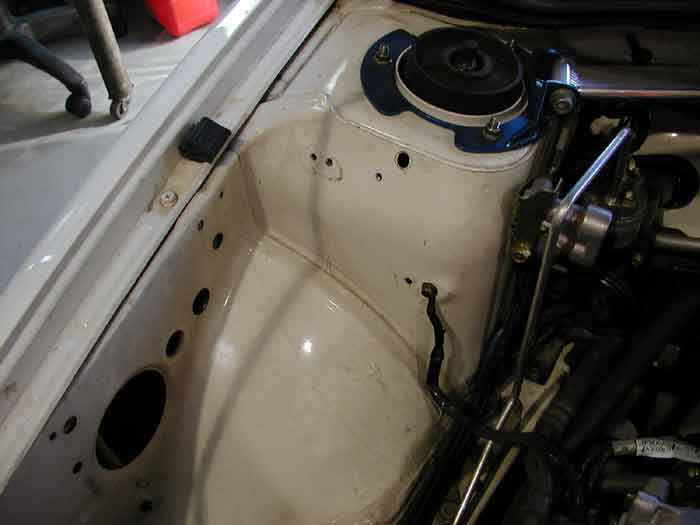

Ok, time for install. Josh recommended that the throttle
body hose be installed first, but that the rest of the intake be assembled
and installed as one whole unit. This made sense because of the placement
of the inlet in the fender. Also, matching up all of the parts while
bending over a car isn't terribly precise. One thing i mistakenly
did during the assembly was to put the filter on in the wrong direction.
The end with the hose clamp is intended to go on the inlet end, not
the manifold end. No big deal.


Once everthing was together, Josh and i installed the
two valve cover vent lines onto the stock fittings. Cobb uses some
nice silicone hose for this, which also means it doesn't stretch too
easily. This meant that getting the ends on took some effort, but
fit on very tightly. At this point we also realized that i had another
peculiarity. Normally the PCV hose is rerouted to the intake manifold,
but mine had some different tubing. Josh rigged together a T fitting
to accomodate both the PCV and valve cover.
 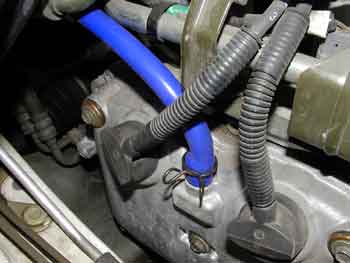
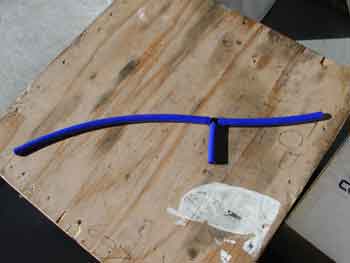
The last part needed before install was to take the
rubber grommet that holds the IAT sensor in place from the stock airbox
to the new one. It's a simple operation, just use some force.
 
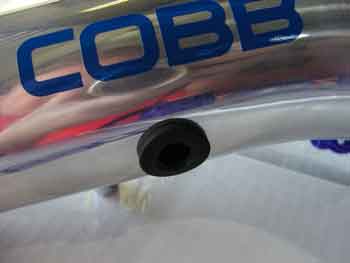 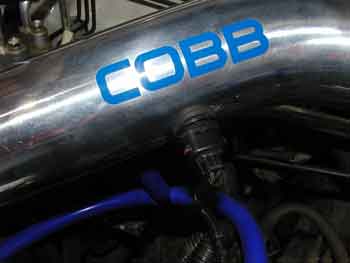
At this point i just slipped the inlet end into the
fender and the other end into the throttle body hose fitting. With
a little shimmying, everything fell into place nicely. There was just
enough clearance between the AC and power steering lines for the piping
to fit. I installed the valve cover lines and IAT sensor, looked it
over, then started it up. No problemo.
 
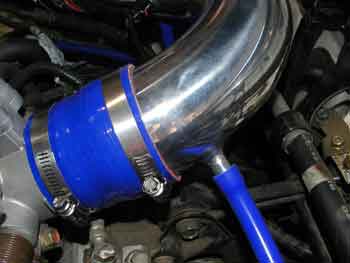

Next up was a test drive. I knew that on load, at higher
RPMs, this intake was known to be somewhat loud. It is. Maybe the
Legacy is indeed better insulated for sound than the RS, which constitutes
a larger percentage of the purchases i'm sure, but i found the sound
on the pleasing side of noisy. It really does let you know that the
engine is working hard and that you're getting everything it has.
I dig it.
The best way to test the effects of modifications like
this, short of dyno time, is to test them in an environment you're
familiar with. Some people have a favorite stretch of road, a point-to-point
section of road, like a stoplight to a telephone pole, a freeway onramp
or a long uphill pull. On my way home, i was able to test the new
part on a couple of these scenarios.
The first one is a freeway onram that starts with a
stoplight, accelerating left towards an uphill pull onto the freeway.
I'd driven this many times with my wagon so i had a relative benchmark.
The morning after i purchased the car, i'd taken the same ramp with
some less than stellar results. This time i was met with near-Wagon
results. I was up to 70 as quick as i remember my Wagon doing it,
to my surprise. Wow.
The second one was much later in the drive, after getting
off I-15. There's a long, 55MPH pull that i normally hold pretty well
in the Wagon. In the Wagon, i was also able to dip into the turbo's
torque and accelerate in 5th, if needed. The three previous runs at
this hill in the Sedan were met with the need to downshift to fourth
in order to hold 60, or to run at 65 and use the revs. After the intake
i was able to hold 60, and maybe get a tiny bit of acceleration, but
nothing worth the extra effort. Cool.
Third is what i call the "Canfield Test" At the intersection
of a highway and road, there's a stopsign. Accelerating right from
the stop sign and judging the amount of space before the next block
(Canfield Rd) and the effort expended (WOT or x/10ths) is the basic
premise. In the Wagon, this was pretty easy. I could get to 60 with
room to spare. Stock intake on, i ran this test at least three times
on different days. All of these times, the results were less than
the performance of the Wagon, with the car struggling to get to Canfield
and reaching 60MPH. The first test after the new intake really, really
surprised me. I was within a carlength of there the Wagon would have
hit 60. It was so much faster that i simply couldn't believe the difference.
Wow.
I'm sold on this. It is a very nice piece of work. Cobb
is known for taking the time to put out some of the best parts available
for Subaru cars and this is no exception. The only drawback even worth
mentioning is the price, which is higher than most, but a solid investment.
Noise can be considered a drawback, but it's a part of the experience
and realistically avoidable in average driving.
Thanks to the guys at Cobb for giving me some space
and helping me install it. |
